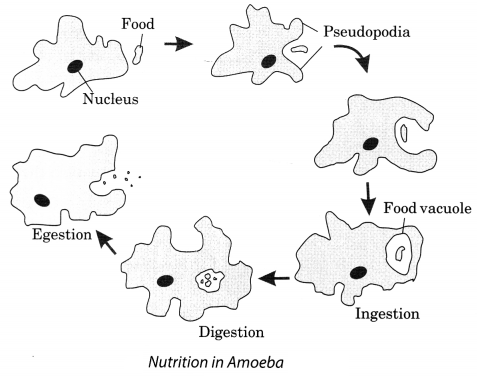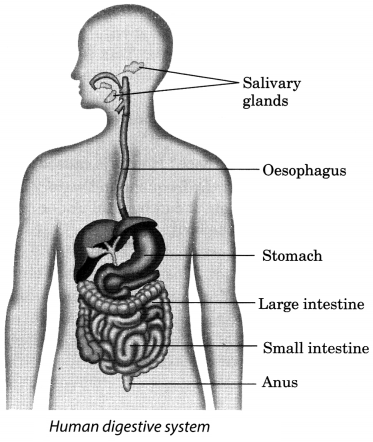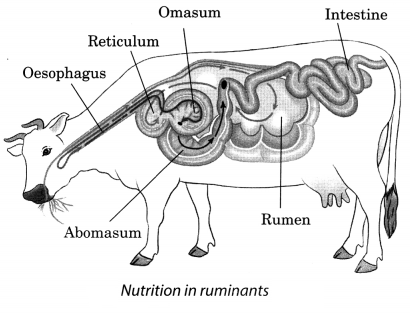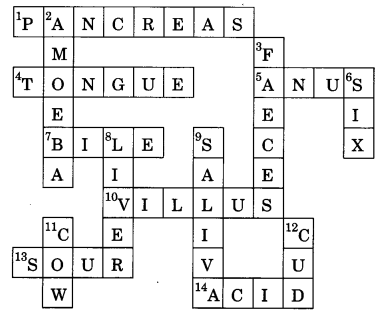In this page, we are providing Nutrition in Animals Class 6 Extra Questions and Answers Science Chapter 2 pdf download. NCERT Extra Questions for Class 6 Science Chapter 2 Nutrition in Animals with Answers will help to score more marks in your CBSE Board Exams.
Class 7 Science Chapter 2 Extra Questions and Answers Nutrition in Animals
Extra Questions for Class 7 Science Chapter 2 Nutrition in Animals with Answers Solutions
Nutrition in Animals Class 7 Extra Questions Very Short Answer Type
Question 1.
Do all animals have the same mode of nutrition?
Answer:
No
Question 2.
Name the mode of nutrition in which solid whole food particles is ingested.
Answer:
Holozoic
Question 3.
Name the chambers in the stomach of a ruminant.
Answer:
Rumen, reticulum, omasum and abomasum
Question 4.
Name the organ which identifies the taste of different food materials.
Answer:
Tongue
Question 5.
What is the other name of foodpipe?
Answer:
Oesophagus
Question 6.
Name the hard outer surface layer of your teeth.
Answer:
Enamel
Question 7.
Name some parasites of human body.
Answer:
Tapeworm and roundworm
Question 8.
What is the other name of digestive tract?
Answer:
Alimentary canal
Question 9.
Which is the largest gland of the human body?
Answer:
Liver
Question 10.
What are taste buds?
Answer:
Taste buds are the receptor cells which helps us in recognising taste of the food.
Question 11.
Apart from tasting food what are the other functions of tongue?
Answer:
Helps in chewing food and speaking.
Question 12.
What is the function of oesophagus?
Answer:
The wall of oesophagus pushes the food down to the stomach.
Question 13.
State the functions of molar and premolar teeth.
Answer:
The functions of molar and premolar teeth are to chew and grind the ingested food.
Question 14.
What is mastication?
Answer:
Mastication or chewing is the process of crushing and grinding of food by teeth.
Question 15.
Name the various types of teeth.
Answer:
- Incisors
- Canines
- Premolars
- Molars
Question 16.
What are milk teeth?
Answer:
The set of teeth that grows during infancy are called milk teeth. They fall off at the age of 6-8 years.
Question 17.
What is peristalsis?
Answer:
A series of contraction and relaxation in alimentary canal which helps in movement of food is called peristalsis.
Question 18.
Define nutrition.
Answer:
The process of intake of food and its utilisation by an organism is known as nutrition.
Question 19.
What is assimilation?
Answer:
Assimilation is the process by which the absorbed food is utilised to build up complex substances (like protein and fat) and to give energy.
Question 20.
Define absorption.
Answer:
The digested food gets absorbed by the inner walls of small intestine and passes into the blood vessels. This process is known as absorption.
Question 21.
Why is digestion of fats difficult as compared to that of other nutrients?
Answer:
Fats cannot be digested easily because they are insoluble in water and are present as large globules.
Question 22.
Does bile juice digest fat completely?
Answer:
No. Bile juice only breaks down big fat droplets into smaller droplets which can be easily digested by the enzymes released from the pancreas.
Nutrition in Animals Class 7 Extra Questions Short Answer Type
Question 1.
Write about pseudopodia.
Answer:
The finger-like projections in Amoeba are called pseudopodia. These projections are not permanent. They are formed out of the body of Amoeba, whenever they are needed. Pseudopodia helps in movement and capturing food.
Question 2.
Name some of the components of food.
Answer:
Some of the important components of food are:
- carbohydrates
- proteins
- minerals
- fats
- vitamins
- water and roughage
Question 3.
What is animal nutrition?
Answer:
Animal nutrition includes nutrient requirement, mode of intake of food and its utilisation in the body for growth, repair and its functioning.
Question 4.
Write the names of various digestive organs of the body.
Answer:
- buccal cavity
- oesophagus
- stomach
- small intestine
- large intestine
- rectum
- anus
Question 5.
Explain the mode of feeding of starfish.
Answer:
Starfish feeds on the animals covered with hard shells of calcium carbonate. After opening the shell, starfish pops out its stomach and eats the soft animal present inside the shell. Then the stomach goes back into the body and the food slowly gets digested.
Question 6.
Explain the process of digestion in stomach.
Answer:
Partial digestion of food takes place here. Stomach releases gastric juice, which mainly contains hydrochloric acid and pepsin. Hydrochloric acid kills germ entering with the food and makes the food acidic. Pepsin helps in digestion of protein. Churning of stomach muscles physically breaks down food and mix it with the gastric juice and convert it into a semi-fluid called chyme.
Question 7.
Write the functions of different types of teeth in human beings.
Answer:
- Incisors: They help in cutting and biting food.
- Canines: They help in piercing and tearing food.
- Premolars: They help in chewing and grinding food.
- Molars: They also help in chewing and grinding food.
Question 8.
Explain rumination.
Answer:
The grass-eating animals quickly swallow the grass while eating which gets stored in a separate part of their stomach called ‘rumen’. Here, the food gets digested partially and is called ‘cud’. Later, this cud again returns to the mouth in small lumps and the animal chews it properly. This process is called ‘rumination’.
Question 9.
Define tongue. What are its functions?
Answer:
The fleshy muscular organ attached at back to the floor of the buccal cavity is called tongue. It is free at front and can move in all directions.
The functions of tongue are:
- It mixes saliva with food.
- It helps in swallowing the food.
- It helps in identifying the various tastes of different food materials, as it has various taste buds which help in detecting them.
Question 10.
Write about Amoeba.
Answer:
Amoeba is a small microscopic, single-celled organism found in pond water. It has a cell membrane, a dense and round nucleus, and many small bubble-like vacuoles in its cytoplasm. Amoeba can change its shape and position constantly.
Question 11.
Explain digestion of food in mouth.
Answer:
Food enters the buccal cavity through mouth. Here it is chewed by teeth, and gets mixed with saliva with the help of tongue. Saliva contains an enzyme called ptyalin (salivary amylase). This enzyme converts complex carbohydrates like starch into sugars. Saliva moistens the food and changes it into a round bolus.
Question 12.
Write about pancreas.
Answer:
Pancreas is a large cream-coloured gland, which is located just below the stomach. It secretes pancreatic juice into the small intestine which acts on carbohydrates, fats and proteins and changes them into simpler forms.
Question 13.
Why the large intestine is shorter and wider than small intestine?
Answer:
In large intestine only absorption of water takes place from the undigested food so it is shorter and wider. In small intestine, digestion takes place therefore more surface area is needed for nutrient absorption. Hence, small intestine is narrower and longer.
Question 14.
Write about large intestine.
Answer:
Large intestine begins with the caecum and ends with the rectum. It includes the caecum and the colon and the rectum. It extracts moisture from food residues which are later excreted as faeces. It is wider and shorter than small intestine; so its length is about 1.5 metre.
Nutrition in Animals Class 7 Extra Questions Long Answer Type
Question 1.
Define dental plaque. What harm can it cause? How can the formation of plaque be prevented?
Answer:
If teeth are not cleaned regularly and properly they get covered with a sticky, yellowish layer of food particles and bacteria. This is called ‘dental plaque’.
Because plaque entirely covers the teeth by its layer, the alkaline saliva cannot reach their surface to neutralise the acid formed by bacteria. Hence, tooth decay is caused. Tooth decay can be prevented by brushing and cleaning the teeth as well as mouth properly and regularly.
Question 2.
What is diarrhoea? How is it caused? How can it be prevented?
Answer:
Diarrhoea is the frequent and watery bowel movement. It could be caused by infection or food poisoning or indigestion. It can be fatal under severe conditions. This disease causes excessive loss of water and salts from the body.
It can be prevented by taking plenty of boiled and cooled water, along with a pinch of salt and sugar dissolved in it. This is called Oral Rehydration Solution (ORS).
Question 3.
Explain feeding and digestion in Amoeba with a labelled diagram.
Answer:
Amoeba feeds on microscopic organisms. When it senses food, it pushes out pseudopodia around the food particle and engulfs it. The food becomes trapped in a food vacuole. Digestive juices are secreted into the food vacuole which act on the food and break down it into simpler substances. Digested food is absorbed into the cell and undigested food is expelled outside by the vacuole.

Question 4.
Explain the process of nutrition in human beings from ingestion to egestion.
Answer:
(i) Ingestion: It is the process of taking food into the mouth; i.e., starting point of the alimentary canal.
(ii) Digestion: Digestion is the process of breaking of ingested food into simpler substances. Digestion occurs through two processes, i.e., mechanical (chewing, grinding, mixing, churning) and chemical (enzymes, bile, acid). Mechanical processes helps in breaking the large food particles into smaller ones and mixing them well with the chemicals secreted by alimentary canal.
Digestion of starch starts at mouth with the action of salivary amylase. Digestion of protein starts in stomach with the help of enzyme pepsin and digestion of all the three components of food, viz., carbohydrate, protein and fat is completed in the small intestine.
(iii) Absorption: Digested food is absorbed into the blood through finger-like structures, called villi, present in the small intestine.
(iv) Assimilation: It is the process where absorbed substances are transported to different organs of the body via blood vessels to build complex substances like protein, enzyme, etc.
(v) Egestion: The process of elimination of undigested food through anus is called egestion.
Question 5.
Explain human digestive system with a labelled diagram.
Answer:

The digestive system in humans consists of an alimentary canal and digestive glands which help in
digestion. Different parts of alimentary canal are:
- Mouth: Digestion begins in mouth. Teeth cuts the food into small bits. Saliva digest starch in food and softens the food to pulp. Tongue helps to mix the food with saliva and converting food into bolus.
- Oesophagus: Wall of oesophagus contracts and transports food from mouth to stomach.
- Stomach: It is a big muscular bag which secretes digestive juice. Hydrochloric acid in digestive juice kill germs and enzyme pepsin breaks protein to amino acids. In stomach food get converted into a semi-fluid, chyme.
- Small intestine: Secretions from liver and pancreas act on the food in small intestine. Bile helps in breaking large fat molecules into tiny droplets. Pancreatic juice helps in digestion of starch and protein. Intestinal juice acts on starch, protein and fat and completes the digestion. Villi in small intestine absorbs these digested nutrients into the blood vessels.
- Large intestine: Large intestine absorbs water and some useful nutrients from the undigested food. The undigested food is then eliminated as faeces from the anus.
Question 6.
Write a short note on nutrition in ruminants.
Answer:
- grass-eating animals swallow the food quickly and store it in the rumen. Rumen inhabits cellulose digesting bacteria.
- The partially digested food then goes to next chamber of the stomach the reticulum.
- Digestive juices of the reticulum turns food into cud.
- While resting, cow brings back the cud into mouth for regurgitation.
- Food is chewed completely and swallowed into omasum for further digestion.
- Then the food moves into abomasum for digestion brought about by digestive juices.
- A large sac-like structure called the caecum lies between the small and large intestines.
- The symbiotic bacteria present in the caecum help incomplete digestion of cellulose. Digestion of food is completed in the small intestine.

Question 7.
Solve the crossword given below:

Answer:
Across:
1. Cream-coloured digestive gland
4. Organ that mixes saliva with the food
5. Point of defaecation
7. Stored in gall bladder
10. Finger-like outgrowth in the small intestine
13. Kind of taste buds
14. Kills bacteria in the stomach
Down:
2. Feeds with the help of pseudopodia
3. Undigested excretory solid residues
6. Total number of molars in one jaw of an adult
8. Largest gland
9. Watery secretion in the mouth
11. A ruminant
12. Form of food chewed by ruminants
Answer:

Nutrition in Animals Class 7 Extra Questions HOTS
Question 1.
Can you tell which kind of food items are not digested easily when gall bladder of a person is removed surgically? Why?
Answer:
Food items rich in fats cannot be digested easily when gall bladder of a person is removed. Gall bladder stores bile juice in concentrated form which is secreted in small intestine when needed. Bile juice breaks the larger molecules of fats into smaller one.
Question 2.
Name the part of alimentary canal where
- water gets absorbed from undigested food.
- digested food gets absorbed.
- bile juice is produced.
- taste of the food is perceived.
- germs get killed.
- undigested food is removed.
- food is converted into bolus.
- food is converted into chyme.
Answer:
- Large intestine
- Small intestine
- Gall bladder
- Tongue
- Stomach
- Anus
- Mouth
- Stomach
Question 3.
What is the role of fibrous food in bowel movement?
Answer:
Fibrous food increases the stool bulk, so it ease the bowel movement and reduce constipation.
Question 4.
How food moves in the opposite direction during vomiting?
Answer:
When food is not accepted by our stomach, then the wall of the alimentary canal pushes back the food in upward direction and it is vomited out.
Question 5.
Why it is advised not to eat hurriedly and talk or laugh while eating.
Answer:
This is because inside the throat, air and food share a common passage. When we talk flap-like valve of wind pipe opens and when we eat or swallow food it remains close. When we eat hurriedly and talk or laugh while eating, the valve of windpipe get open or does not close properly. If, by chance food particles enter the windpipe, we feel choking or get hiccups.
Nutrition in Animals Class 7 Extra Questions Value Based (VBQs)
Question 1.
In a birthday party, Ram filled his plate with oily and sugary food. His elder sister Sarita on seeing this interrupted him. She told him that it is not good to eat too much of this kind of food. She asked him to share that plate with his friends and suggested to include some vegetables and salads also.
(a) Why eating oily and sugary food not good for health?
(b) What is the effect of sugary food on our teeth? How we can prevent it?
(c) Where do sugary food get digested in alimentary canal?
(d) What value of Sarita is shown here?
Answer:
(a) Too much sugary food and oily foods are not good for health as it causes secretion of much acid from stomach and thus causes indigestion. Sugary foods causes tooth decay, makes our stomach feel full and in long term obesity. Oily food also cause obesity and thus many health problems.
(b) Sugary food sticking to our teeth facilitates growth of harmful bacteria which break down the sugars into acids. This acid gradually damage the teeth causing tooth decay. We can prevent tooth decay by brushing our teeth at least twice a day and rinse the mouth after every meal. We must also avoid too much chocolates, sweets or sugar products as they are the major cause of tooth decay.
(c) Sugary food gets digested in small intestine.
(d) Sarita is intelligent, understanding and knows value of food so instead of throwing oily and sugary food she asked Ram to share it with his friends.